Food coloring is arguably the second most important element in cookie decorating after the royal icing itself. The art of choosing colors and/or mixing the exact shade are the subjects of many blog posts, one of the early Practice Bakes Perfect challenges, and even a book, but I am not going near those topics here! This post will only deal with the more "technical" aspects of food coloring, such as its composition, the preferred types and brands of food coloring around the world, and a comparison of brands available to me in South Africa.
Food Coloring Overview
Food coloring comes in different shapes and sizes and is used in different ways. I will not address the supermarket brands of food coloring, which are primarily of the less concentrated, liquid variety and, therefore, less frequently used in cookie decorating. Instead, I'll focus on the powder and gel colors. (These forms are the only ones available here in South Africa anyway.)
The same color pigments lie at the basis of powder colors and gel colors. Extra ingredients are added to make the powder into a gel, and those ingredients vary depending on whether the end product has to be water soluble (i.e., for royal icing) or oil-based (i.e., for chocolate). One manufacturer told me that “making concentrates isn’t as simple as adding more color, as eventually the mix will be too thick to blend. So, once again, one needs to add various other products or blend other colors to get the depth of concentrate required."
Food Coloring Around the World
As you may know, we launched a survey not long ago on Cookie Connection to find out about people’s preferences for particular types (i.e., gel, powder, paste, liqua-gel, etc.) and brands of food coloring. Of the 171 people who have responded thus far, 68% (116) are from the United States (US), 7% (12) are from Canada, and the rest hark from 25 other countries. All data shared below relate to food coloring used to tint royal icing; we asked similar questions for painting on royal icing, and those results can be found here.
Type Use: Overall, a whopping 92% of respondents use either gel (71%) or liqua-gel (21%) food coloring to tint their royal icing. However, use of liqua-gels (which typically come with a dropper top) is more widespread in the US than elsewhere in the world. In the US, about 66% of respondents use gel and 26% use liqua-gel, whereas, in all the other countries combined, gels are used by 82% of respondents and liqua-gels by only 9%. These differences can perhaps be explained by the greater use/availability of Wilton colors in other countries (see "Brand Use" below), which are available only as gels in lidded containers.
The top three factors in deciding what type of food coloring to use in royal icing are (1) the coloring's concentration (63%), with more being better; (2) ease of dispensing (39%); and (3) availability in one's local area (29%), with "distributes most uniformly in icing" being a close fourth (26%).
Brand Use: Two brands dominate the world! Of all 171 respondents, 63% cite AmeriColor as their primary brand for tinting icing, and 22% cite Wilton. Chefmaster is a very distant third with only 5% reporting use. As with type use, there are some differences in brand use between the US and other parts of the world. In the US, AmeriColor is an even more dominant player, with 74% citing it as their primary brand, and only 17% citing Wilton. However, in all the other countries combined, AmeriColor and Wilton are much more evenly matched, with 44% using AmeriColor and 35% using Wilton.
While only 49% of respondents purchase their primary brand locally in a brick-and-mortar shop, local availability is still the most cited reason (41%) for selecting one's brand, followed by "most concentrated" (37%), "easiest to dispense" (23%), and, in a virtual tie for third place, "has the widest range of colors" (21%).
Respondents seem relatively happy with their primary brand of food coloring, as 70% reported not being able to think of anything that would improve it. However, of the 51 respondents who did cite improvements, 16% want better flavor particularly in dark shades of red, black, and blue, followed by 14% who seek greater coloring intensity to minimize the quantity needed to create dark shades, staining of teeth, and use of artificial colors. In third and fourth places, respectively, are the desire for a better dispenser (12%) among lidded container- and Wilton-users and a viable natural coloring choice that colors intensely (10%). Now, if someone could solve all of these dilemmas, they'd be sitting on a gold mine!
More About South African Brands: Since I live in South Africa and was able to do some primary research on local brands here, I thought I'd share it with you too! The best known American brands of food coloring in South Africa are AmeriColor and CK Products. CK Products colors are available in large (4.5-ounce and 13.5-ounce) bottles, whereas AmeriColor is often only available in a smaller (0.75-ounce) size. Both brands are typically displayed side-by-side in stores on an aisle end cap, organized by color rather than brand.
Furthermore, I have found four (!!!!) South African brands of food coloring: Barco, Cake Flora, Rolkem (exports internationally), and Sweet Celebrations. The first three have gel and powder options available; the fourth is only available in gel color.

Rolkem color wall in a cake supply shop, February 2016.
 The Barco wall display has replaced the Rolkem display. There seems to be an all-or-nothing policy with regards to stocking a local brand.
The Barco wall display has replaced the Rolkem display. There seems to be an all-or-nothing policy with regards to stocking a local brand.
Rolkem makes its own colors and derives its color pigments from plant material or minerals, and so are considered natural colors. Barco indicated that most of their base colors are imported. (On the side, I must add that it took this blog post to realise that I have been driving two streets past the Barco premises almost every day for the last five years! How is that for local?!). Barco specified that their product is kosher. It is striking how the Cake Flora bottle and text on the label are identical to those of AmeriColor. On an older Cake Flora bottle, it was mentioned that it is a product of the US. On new bottles, this reference has been dropped, and I received confirmation by email that it is produced in South Africa. I wonder if the color pigments are imported and/or if the AmeriColor recipe is used to constitute the gels here in South Africa? Sweet Celebrations specifies that their product is halaal, and, again, it is only available in a gel format.
An Experiment
I compared the four South African gel food coloring brands with CK Products and AmeriColor gel food coloring. I also did a quick comparison of two powder colors. I must make a comment here: I could not find AmeriColor black gel, and not all brands had the same red, green, or purple available.
While details like gel consistency and user-friendliness of the bottle can be important, I did not want them to detract from the bigger purpose of my test: to determine how each coloring works in royal icing. My experiment focuses on the intensity and hue of colors achieved under different conditions.
To test the gel colors, I made royal icing with fresh egg whites and confectioner’s sugar (icing sugar) and no further additions. I portioned the icing into equal 100 ml (3.3-ounce) test units. First, I mixed in one (1) small drop of gel food coloring; then I added two (2) more drops; and then I added three (3) more drops for a total of six (6) drops. That same day, I used some of the icing to flood cookies (without paying too much attention to consistency). The icing was then left to stand for two days and checked again. Lastly, I added a drop of lemon juice and a sprinkle of cream of tartar to check if the icing color would be affected by these acids. (My hypothesis was that the Rolkem colors would be more acid-sensitive, as many natural colorings are.)
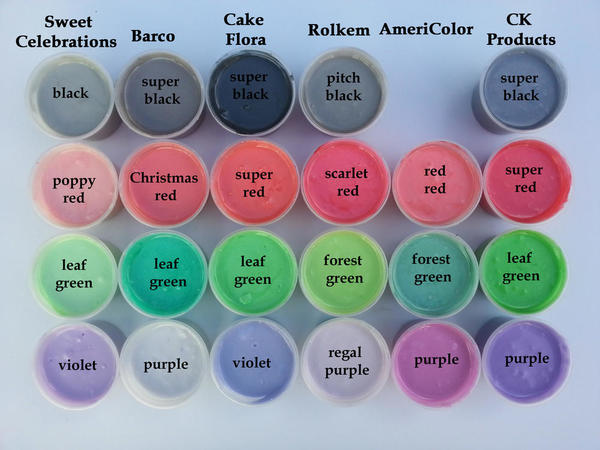
Brands and colors of gel food coloring used in the test. Here, one drop of gel food coloring has been added.
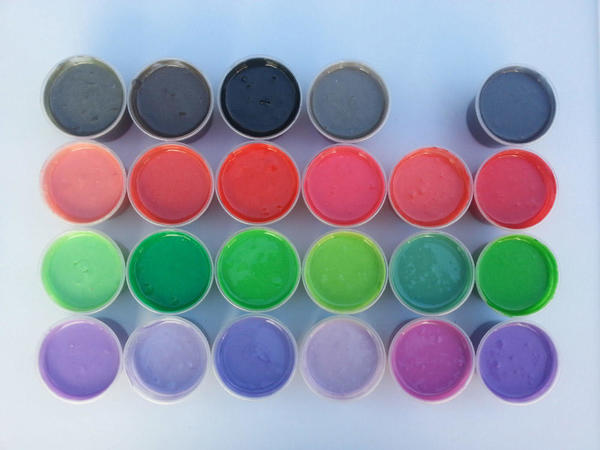 Depth of color after three drops of gel food coloring.
Depth of color after three drops of gel food coloring.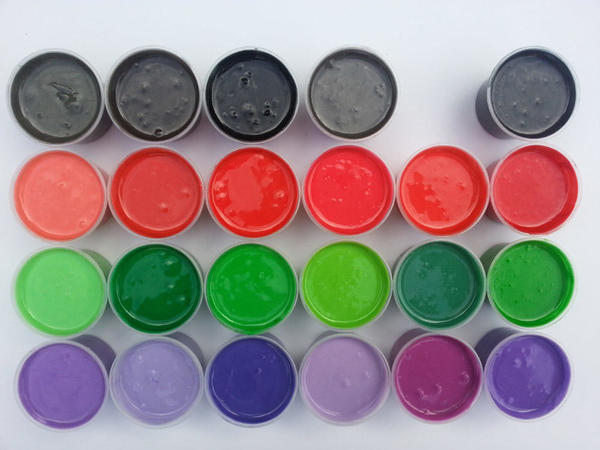 Depth of color after six drops of gel food coloring.
Depth of color after six drops of gel food coloring.
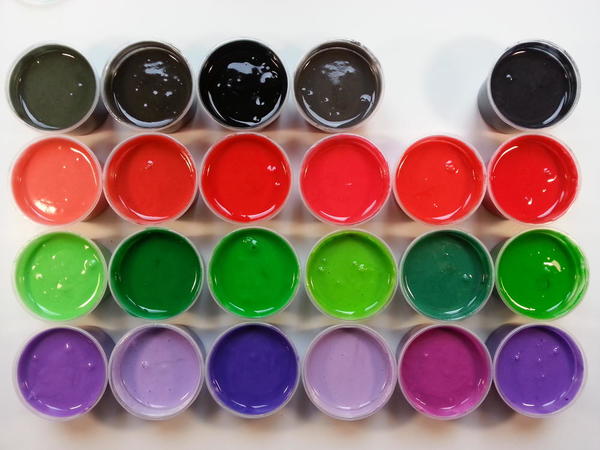 Royal icing after "maturing" for two days.
Royal icing after "maturing" for two days.
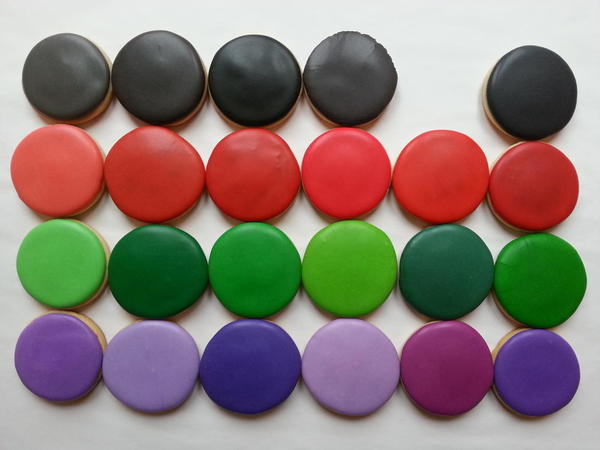 Cookies flooded with royal icing tinted with six drops of gel food coloring.
Cookies flooded with royal icing tinted with six drops of gel food coloring.
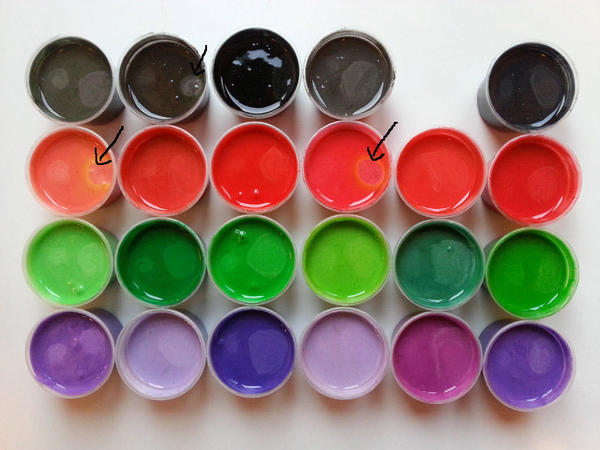 Lighter spots show where cream of tartar (on the left) and lemon juice (on the right) have affected the color. Arrows indicate where the acid has changed the color of the royal icing.
Lighter spots show where cream of tartar (on the left) and lemon juice (on the right) have affected the color. Arrows indicate where the acid has changed the color of the royal icing.
It was immediately clear which brands of gel coloring tinted the least and most intensely. Even with six (6) drops of coloring, I couldn't obtain a deep color in any hue with Sweet Celebrations (which, incidentally, has the runniest consistency). And the Sweet Celebrations red never lost its pink hue even with lots of gel added. Cake Flora colored the most intensely by far, and was the only brand that obtained a truly saturated black with six (6) drops of coloring. None of the colors deepened much in the course of two days, leaving the other brands of black still relatively unsaturated after the "maturing" process. And contrary to my hypothesis about Rolkem being more acid-sensitive, lemon juice (on the right in each container) and cream of tartar (on the left) lightened most of the colors, but none really changed color. The arrows in the picture above indicate the most significant color changes that occurred. [EDITOR'S NOTE: Having seen these results, I wonder how "natural" Rolkem coloring really is, as most pigments that are anthocyanin-based change color rather dramatically with the addition of acid. Plus, the Rolkem hues are very bright and not typical of what you see with other natural colorings like TruColor and India Tree.]
Now for the powder colors! As noted above, I had two brands of powder colors available: Barco and Rolkem. I mixed the coloring into the royal icing in four different ways: (1) I dropped Rolkem Quick Dry Essence (a wet applicator of powder colors) immediately on top of a knife point-worth of powder on the royal icing; (2) I mixed 3.5 ml vodka with ¼ teaspoon color powder and used half of this solution in the icing; (3) I repeated method two, but used the same amount of water instead of vodka; and (4) I did a dry mix by blending a knife point of powder directly into the royal icing. As expected, there was some spotting with the last method, but much less than I anticipated!
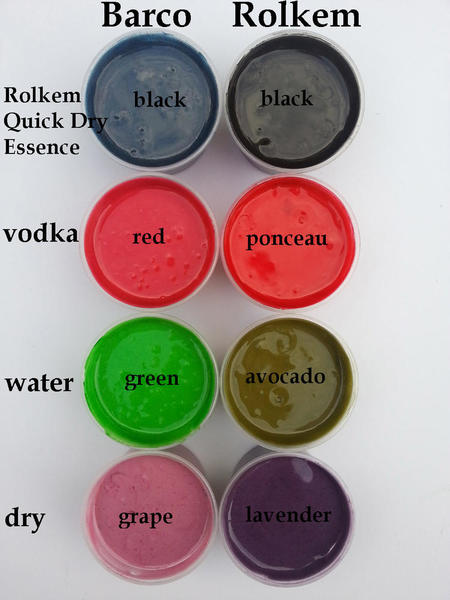
Royal icing tinted with powder color in different ways.
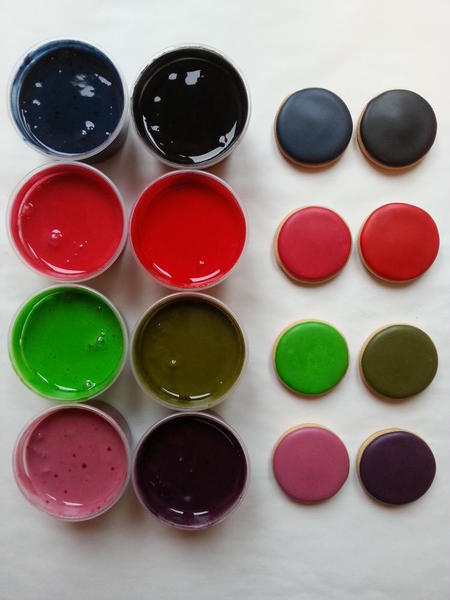
Royal icing tinted with powder color and left to "mature" for two days; and flooded cookies.
While the overall results with the powder colors were much better than I thought they would be, these colors had two drawbacks: (1) it is a messy business to scoop them out of their vials, and (2) it is hard to accurately measure how much coloring you are adding.
This experiment has left me amazed by the variety of hues and wide range of coloring intensity across brands. It might almost be worth it to try out all of the colors like this and build a color library. I was mostly using AmeriColor and then CK Products when I started buying bigger bottles of food coloring. But as these colors run out, I think I will replace them with Cake Flora, certainly for black. As we say here: local is lekker!
[EDITOR'S NOTE: If you haven't yet taken our food coloring survey, please do! We're always interested in adding your experiences to our database. Just click here to respond. Thank you!]

Liesbet Schietecatte, born in Belgium but permanently living in South Africa since 2005, accidentally found her way into cookie decorating in 2012. Grabbing moments in between her career as an archaeologist and being a mommy and a wife, Liesbet bakes Belgian biscuits like speculoos in the tradition of her grandmother’s family who were bakers for several generations, but she gets the most creative satisfaction from decorating with royal icing. She bakes and decorates for occasional orders and at times for a crafters' market, but mostly for the enjoyment and challenge of trying out new things. To honour her family's baking legacy, Liesbet uses the family name to give a home to her baking pictures on Facebook: Stock’s – Belgian Artisan Bakes.
Photo credit: Liesbet Schietecatte
Note: Toolbox Talk is a bimonthly Cookie Connection blog feature written by Liesbet Schietecatte that explores similarities and differences in cookie tools and ingredients from all over the world. Its content expresses the views of the author and not necessarily those of this site, its owners, its administrators, or its employees. Catch up on all of Liesbet's past Cookie Connection posts here.

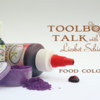
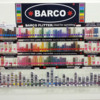
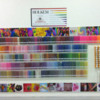
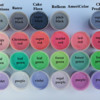
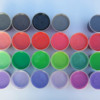
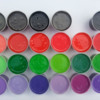

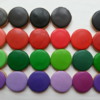
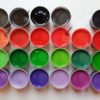

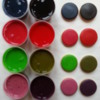
Comments (12)